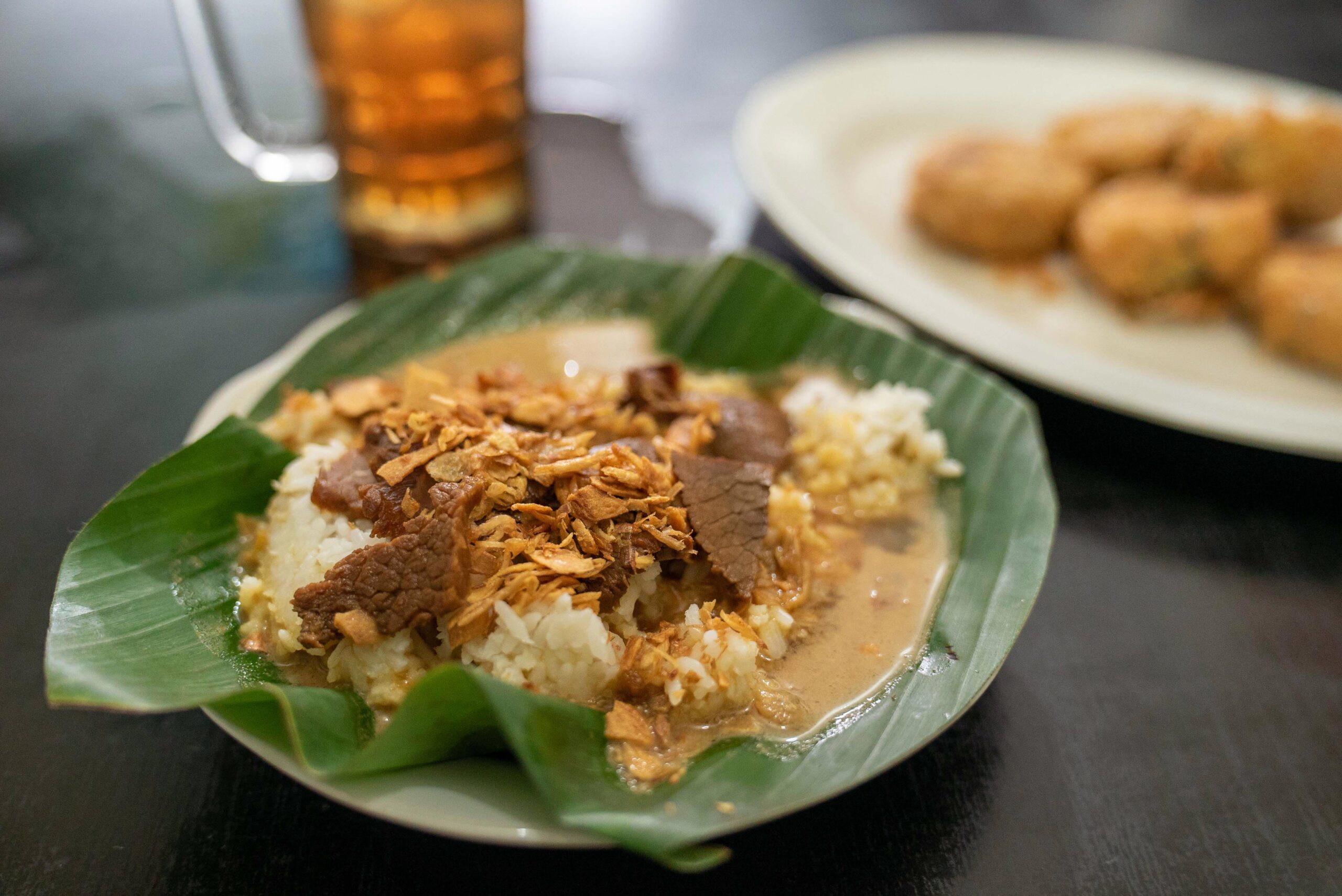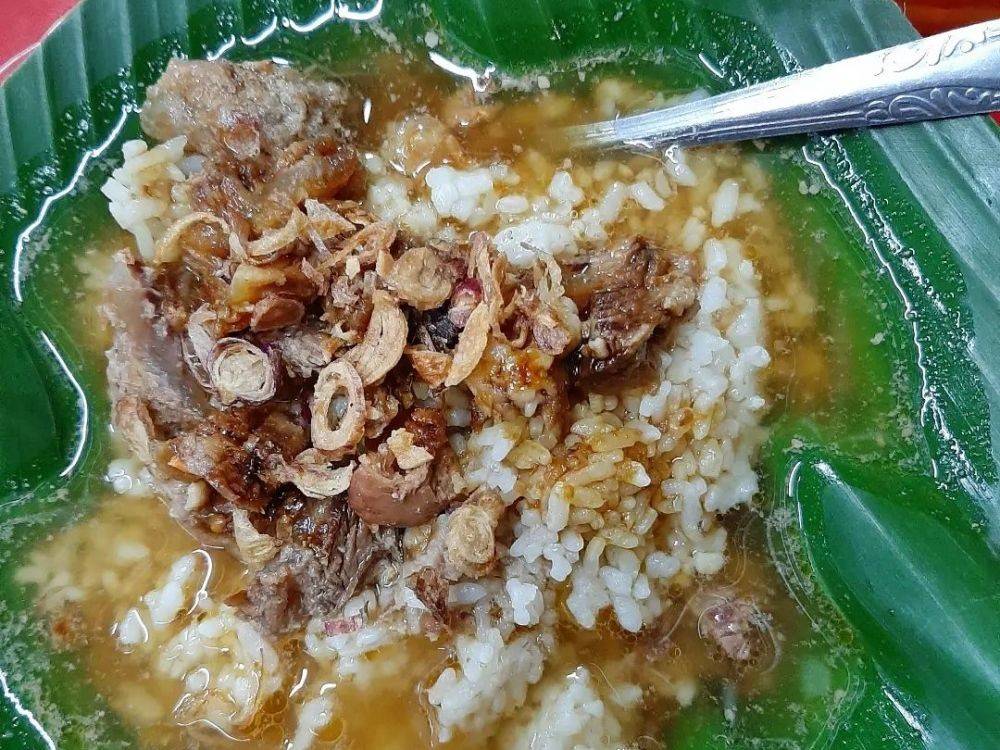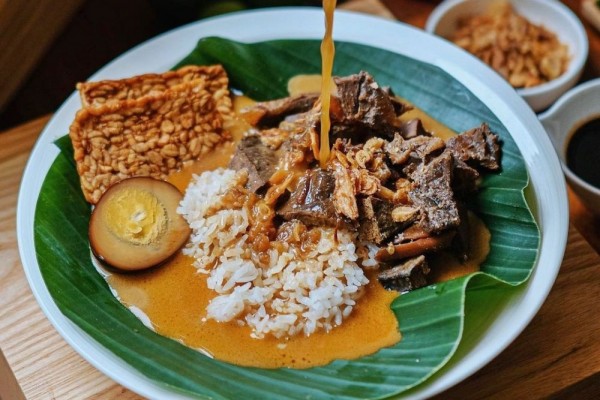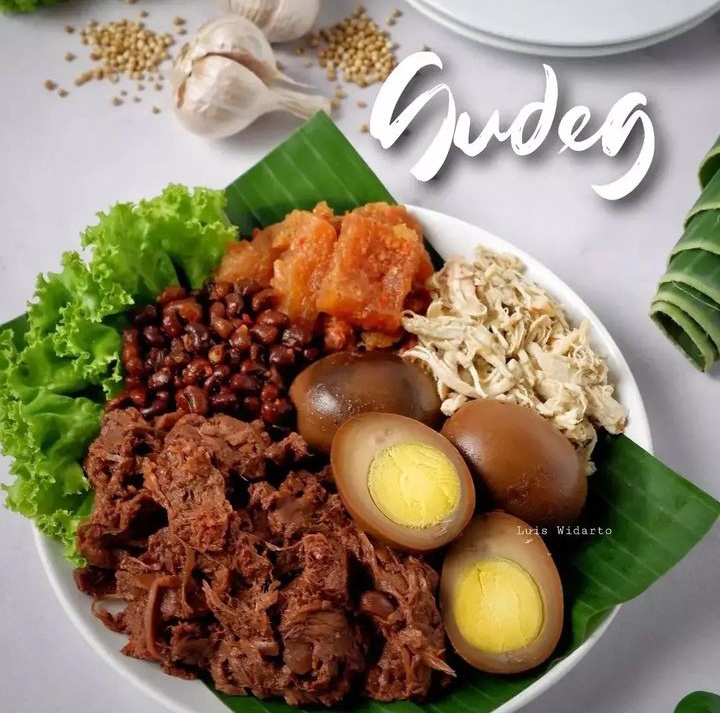
Nasi Gandul: The Heartwarming, Dangling Delight of Pati, Central Java
In the vast and flavorful tapestry of Indonesian cuisine, some dishes stand out not just for their taste, but for the stories, rituals, and cultural identity they carry in every spoonful. Nasi Gandul is one such culinary icon. Hailing from the regency of Pati in Central Java, this humble yet profoundly complex dish is more than just rice and soup; it is a bowl of history, a testament to Javanese culinary philosophy, and a heartwarming experience that lingers long after the last bite.
At first glance, Nasi Gandul might seem deceptively simple: a plate of steamed rice lavishly doused in a dark, aromatic beef soup, accompanied by a selection of fried offal and meat. But to dismiss it as just another regional soup would be to miss the point entirely. The magic of Nasi Gandul lies in its intricate balance of flavors, its unique serving traditions, and the folklore woven into its very name.

The Anatomy of a Soulful Dish
To truly understand Nasi Gandul, one must first dissect its components, each playing a crucial role in the final symphony of taste and texture.
The foundation, as the name suggests, is nasi (rice). The rice is served warm and fluffy, traditionally presented on a plate lined with a banana leaf. This isn’t merely for aesthetics; the heat of the rice and soup gently wilts the leaf, releasing a subtle, earthy fragrance that infuses the entire meal.
The undisputed star of the show is the kuah, or soup. This is where the dish distinguishes itself. It is a rich, savory, and slightly sweet broth that defies easy categorization. It’s not quite a gulai (curry), nor is it a soto (traditional Indonesian soup). The kuah of Nasi Gandul is its own entity. Its deep, dark-brown color comes from a blend of spices, with the most prominent being kluwek (the black nut that also gives rawon its signature color and flavor), which imparts a nutty, earthy, and almost smoky depth. This is layered with a chorus of other aromatics: galangal, lemongrass, bay leaves, shallots, garlic, and a hint of palm sugar for a touch of Javanese sweetness. The broth is simmered for hours with beef, allowing the meat’s essence to meld completely with the spices, creating a velvety, full-bodied liquid that is both comforting and complex.
Floating within or served alongside this magnificent broth is the lauk, the protein accompaniments. The primary choice is tender, slow-cooked beef, but the true Nasi Gandul experience invites diners to be adventurous. A typical Nasi Gandul stall will display an enticing array of pre-cooked options, which the customer can choose to have cut up and added to their bowl. These often include:

-
- Empal: Slices of beef that have been boiled in spices, pounded flat, and then fried to a perfect balance of tender and crispy.
- Paru: Fried beef lung, which becomes light, airy, and wonderfully crunchy.
- Limpa: Spleen, which has a rich, dense texture.
- Babat: Tripe, offering a chewy and satisfying bite.

- Iso: Intestine, known for its soft texture and ability to soak up the flavorful broth.
- Perkedel: A savory potato fritter, which adds a soft, starchy element to the meal.
- Tempe Bacem: Tempeh marinated in a sweet concoction of palm sugar and spices, then fried.
This “choose-your-own-adventure” style of protein selection allows each bowl of Nasi Gandul to be a personalized creation, tailored to the diner’s preference for texture and flavor.

The Dangling Mystery: What’s in a Name?
The name “Nasi Gandul” itself is a source of much local lore and friendly debate. Gandul is a Javanese word that means “to dangle” or “to hang.” There are several popular theories as to how the dish earned this peculiar name, each adding to its mystique.
The most widely accepted theory relates to the traditional method of selling the dish. In the past, vendors would carry their wares using a pikulan, a long bamboo pole balanced across their shoulders. On one end hung a large pot (kuali) filled with the hot soup, and on the other, a basket (tenggok) containing the rice and other ingredients. As the vendor walked through the villages, the pot and basket would swing and “dangle” from the pole, hence Nasi Gandul.
A second theory points to the serving style. When a customer orders, the seller scoops the rice onto the banana leaf-lined plate. Then, as they ladle the soup and toppings over the rice, the plate is often held in a way that it appears to be suspended or “dangling” in the air, not quite touching the countertop. This momentary act of the rice “dangling” before being served is said to have inspired the name.
A third, more playful explanation suggests that the name came from the diners themselves. As they sat on low stools (dingklik) and ate, their feet would often dangle, not reaching the floor. The name, therefore, might be a lighthearted reference to the posture of those enjoying the meal. Whichever theory holds true, the name “Nasi Gandul” is evocative, memorable, and forever tied to the dish’s humble, itinerant roots.

The Ritual of Eating: A Banana Leaf Spoon
The unique traditions of Nasi Gandul extend beyond its name and ingredients to the very act of eating it. Authentically, Nasi Gandul is not eaten with a conventional metal spoon and fork. Instead, it is enjoyed with a suru, a small, spoon-like utensil crafted from a folded banana leaf.
The use of the suru is a masterstroke of culinary tradition. Proponents claim it significantly enhances the dining experience. A metal spoon can impart a subtle, often imperceptible metallic taste that can interfere with the delicate balance of spices in the broth. The banana leaf suru, on the other hand, is neutral. Better yet, as it scoops up the warm soup, it releases its own faint, fresh aroma, adding another sensory layer to the meal. The act of eating with a suru also forces one to slow down, to savor each bite, connecting the diner more intimately with their food. It is a simple, eco-friendly tool that embodies the Javanese appreciation for nature and simplicity.
The Cradle of Flavor: Pati and Desa Gajahmati
While Nasi Gandul can now be found in major cities across Indonesia, its heart and soul remain in Pati, Central Java. Specifically, the dish is widely believed to have originated in a small village within the regency called Desa Gajahmati. To this day, many of the most celebrated Nasi Gandul sellers in Pati and beyond can trace their lineage or their recipe back to this village.
The dish is a perfect reflection of the region’s culinary palate, which favors a harmonious blend of savory (gurih) and sweet (manis). It stands as a proud culinary ambassador for Pati, a regency more commonly known for its agriculture. For people who have migrated from Pati to other parts of Indonesia, a bowl of Nasi Gandul is more than food; it is a potent taste of home, a cure for homesickness, and a direct line to the memories and flavors of their childhood.
A Legacy in a Bowl
Nasi Gandul’s enduring popularity is a testament to its ability to be both deeply traditional and universally appealing. It is a dish born of humility, sold from a dangling pole, and eaten with a leaf. Yet, its flavor profile is as sophisticated and satisfying as any gourmet creation. It represents a core tenet of Javanese culture: finding richness and contentment in simplicity.
To eat Nasi Gandul is to partake in a ritual. It begins with the visual feast of toppings, the difficult but delightful choice of what to add to your bowl. It continues with the aroma of spices and banana leaf rising to meet you. It culminates in the first spoonful of that dark, magical broth, a wave of savory, sweet, and earthy flavors that warms you from the inside out.
So, should you ever find yourself in Central Java, or spot a humble eatery with “Nasi Gandul Khas Pati” written on its sign, do not hesitate. Step inside, take a seat on a low stool, point to your preferred cuts of meat, and prepare for a journey. You won’t just be eating a meal; you will be tasting a story—a dangling, delicious, and deeply soulful piece of Indonesian heritage.

Nasi Gandul: The Heartwarming, Dangling Delight of Pati, Central Java pictures collections gallery
Nasi Gandul: The Heartwarming, Dangling Delight of Pati, Central Java is a nice pictures and stock photo for your computer desktop or your smartphone device (ipad, tablet, blackberry, iphone, and other device) and also for your personal use. Free available for desktop wallpaper or additional image collections for your all needs. And was uploaded by admit at date July 1, 2025. You can download it in your computer by clicking download button to save image... have nice day and have fun guys..
This 1 image in featured post from 0 Photos/images Gallery and awesome picture selections about Nasi Gandul: The Heartwarming, Dangling Delight of Pati, Central Java is available to download. "Download & Save" images/pictures/wallpapers now and this Is one of the post that listed in packed to Category is Foods directory, with image dimension/resolution size is 2560 × 1710 px and size image/picture file is 481 KB with original link post ID is : https://powae.pw/of-course-here-is-a-1200-word-article-about-nasi-gandul/. Get download/save images in post and gallery, "download" images or "preview" it on a bigger image for spesification sample in Large size (full attachment size) here : [Download & View to Large size]. Just Simple way, in thumbnail or in Gallery. *Click images to view Large Size.We collect this wonderful image from online and choose one of the best for you. Pictures collection that posted here was carefully chosen and published by author after choosing the ones which are best among the others. So, ultimately we make it and here these list of best image for your inspiration and informational reason regarding the Nasi Gandul: The Heartwarming, Dangling Delight of Pati, Central Java as part of blogsite exclusive updates collection. So, take your time and find the best informations and pictures posted here that suitable with your needs and use it for your own collection and personal use. About Image information: Image has been submitted and You are able to give your opinion as evaluations to our web site value.
Don't forget to comment if you interest with this images, you can share this post to social media like as facebook, twitter, google+, pinterest, stumbleupon, and more. just click social media buttons for share this post Nasi Gandul: The Heartwarming, Dangling Delight of Pati, Central Java Now. :)
Thanks for your visit, I hope you happy come to opo wae, wis opo wae, and get what you're looking for. And hope sometimes you will come back again here. All you need to do is help us develop by discussing this Nasi Gandul: The Heartwarming, Dangling Delight of Pati, Central Java if you like it "leave your comment". have fun, Thank you.




